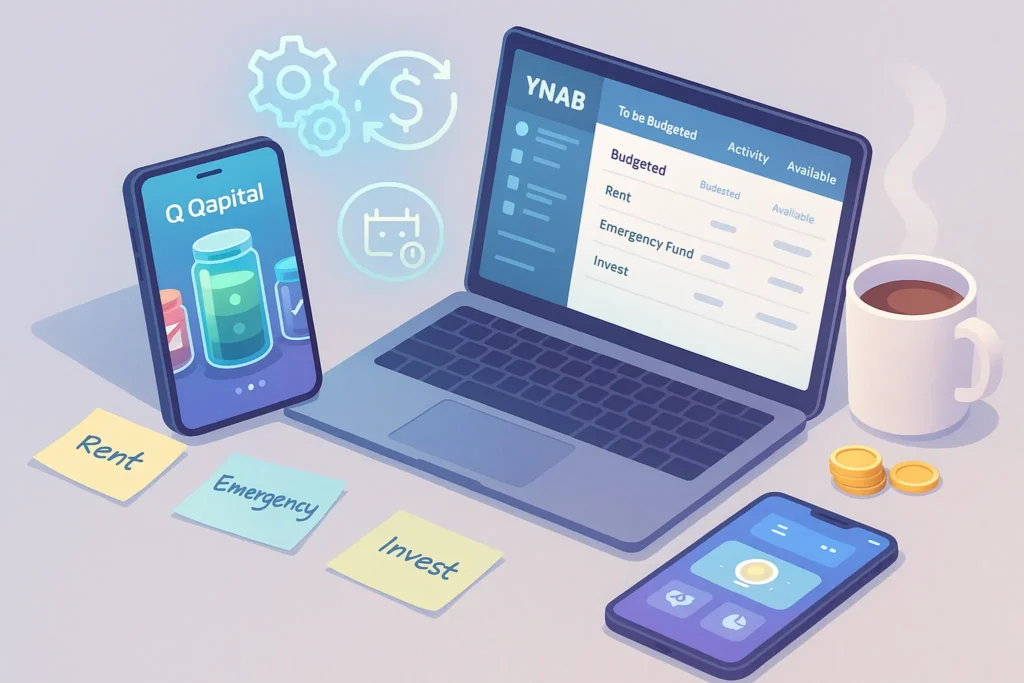-This post may contain affiliate links. If you click on one and make a purchase, I may earn a small commission at no extra cost to you.-
🧠 Introduction: Why Financial Automation Isn’t Just a Hack—It’s a Lifeline
Managing your money shouldn’t feel like a second job.
But for most people—especially freelancers with unstable income, employees juggling bills, or students watching every dollar—keeping up with saving, budgeting, and investing can be mentally draining. It’s not about laziness; it’s about mental bandwidth.
That’s where automation steps in. With the right tools, you can set up rules and workflows that:
-
Save money before you even touch it
-
Invest your spare change without effort
-
Track spending and flag subscriptions automatically
-
Build a realistic budget and stick to it—with minimal friction
In this post, we’ll cover the best tools available in 2025 to automate your personal finances—from autosave apps like Qapital, to robo-investors like Acorns, and auto-budgeting systems like YNAB or Monarch. Whether you’re a broke college student or a mid-career solopreneur trying to stay afloat, there’s something here for you.
Let’s start by understanding your financial context.
🎯 Use-Case Layering: Different Lives, Different Needs
🧑💻 Freelancer with Irregular Income
Freelancers often deal with the “feast or famine” cycle. One month’s windfall can be followed by three months of silence. Financial automation helps by:
-
Automatically transferring a percentage of each payment to a savings buffer
-
Breaking monthly expenses into weekly budgets
-
Forecasting low-income months using tools like PocketSmith
👩💼 Salaried Professional with Predictable Income
You get paid on the same day every month. That’s great for predictability—but still leaves room for poor money habits. You can:
-
Auto-invest a fixed amount monthly into ETFs using Stash
-
Set rules for recurring savings goals (e.g. vacation, emergency fund) with Qapital
-
Use Truebill to cancel forgotten subscriptions and track bills
🎓 Student on a Tight Budget
When your bank account hovers near zero, every dollar matters. You need tools that:
-
Automatically round up transactions to build micro-savings (Acorns)
-
Set ultra-lean monthly budgets with alerts using YNAB or Monarch
-
Avoid overdrafts by syncing your real-time balance into Google Sheets via Tiller
🛠️ The Best Personal Finance Automation Tools for 2025
🧠 1. Qapital – Rule-Based Saving for Life Goals
Qapital relies on behavioral psychology to help users save without thinking about it. The real strength of Qapital lies in its custom “rules” engine—you can set savings triggers based on your habits, calendar events, location, or even IFTTT integrations. This makes it perfect for users who struggle with manual savings. It’s especially helpful for freelancers and students who need to build saving habits passively while managing other financial stress.
What it does: Qapital lets you create customizable “saving rules” that work silently in the background. Think of it as programmable savings jars.
Use Cases:
-
Set a rule to round up every purchase to the nearest $2 and save the difference
-
Automatically save $10 every time you skip takeout
-
Trigger savings when a keyword appears in your calendar (e.g. “Workout” → save $5 for your health fund)
Why it works: It plays on behavioral psychology—turning money habits into positive reinforcement loops. Ideal for visual thinkers and goal-oriented savers.
📌 Best for: Habit hackers, students saving for trips, anyone who wants automation without spreadsheets.
💡 Nerd Tip: Stack Qapital with a budgeting tool like Monarch for best results—one handles saving, the other manages spending.
These tools are just the tip of the iceberg. If you’re curious about smarter, AI-powered budgeting apps, check out our full roundup of the Best AI Personal Finance Apps.
🧠 2. Acorns & Stash – Effortless Micro-Investing
Acorns works best for users who prefer “invisible investing”—rounding up purchases to invest small amounts in ETFs. It’s ideal for passive users or budgeting beginners. Stash, on the other hand, offers more control and education, allowing you to pick stocks or themes like “Green Energy” or “Tech Giants.” It’s better for users who want to learn investing by doing. Both platforms are beginner-friendly but serve slightly different learning curves and engagement levels.
These two platforms offer beginner-friendly ways to invest automatically—without needing a finance degree.
🔹 Acorns
-
Rounds up each purchase to the nearest dollar and invests the “spare change”
-
Offers portfolios based on your risk profile
-
Adds options like retirement IRAs and “Recurring Investments” for as little as $5/week
🔹 Stash
-
More control over what you invest in: ETFs, fractional shares, themed portfolios (like Clean Energy, Tech Giants, etc.)
-
Includes banking tools, stock-back rewards, and early paycheck features
⚖️ Nerd Tip: Use Acorns for passive investing, and Stash to experiment with individual picks.
Micro-Comparison: Acorns vs Stash
| Feature | Acorns | Stash |
|---|---|---|
| Best for | Hands-off investors | Users who want stock choices |
| Cost | $3–5/month | $3–9/month |
| Bonus | Round-up automation | Stock-back debit card |
📌 Best for: Freelancers and new investors who want to start small and stay consistent.
🧠 3. YNAB (You Need A Budget) – Take Total Control
YNAB is built around a zero-based budgeting system, where every dollar is given a job. What makes it unique is how it teaches users to break the paycheck-to-paycheck cycle by aging their money and focusing on priorities. It’s ideal for users who want full control and accountability, especially those with variable income. YNAB also supports goal tracking and debt paydown strategies with clarity and structure.
YNAB isn’t just a budgeting app—it’s a mindset. It helps you “give every dollar a job”, and proactively plan based on what you have, not what you wish you had.
Key Features:
-
Real-time syncing with your bank accounts
-
Age-of-money tracker (shows how long your money lasts)
-
Goal-setting features for debt payoff, savings, and more
It’s especially powerful for freelancers who receive irregular income and need to stretch their cash flow wisely.
📌 Best for: People who want precision, not just tracking. Great for families or self-employed.
Freelancers juggling unpredictable income often need more than just budgeting—they need automation across the board. Don’t miss our curated guide to the Best AI Tools for Freelancers.
🧠 4. Monarch – YNAB’s More Visual Cousin
Monarch is perfect for users who want detailed financial planning but with a visually driven interface. It’s especially strong in collaborative budgeting for couples or families, and includes tools for long-term planning like retirement or big purchases. Monarch pulls data from multiple accounts into live dashboards and supports shared goals, making it feel like a command center for your financial life.
Monarch is newer but rising fast. It takes many YNAB principles but wraps them in a more modern, collaborative interface.
What stands out:
-
Shared budgeting with spouse or partner
-
Gorgeous visual dashboards
-
Long-term financial forecasting
If YNAB feels like a spreadsheet, Monarch feels like a personal finance command center.
Micro-Comparison: YNAB vs Monarch
| Feature | YNAB | Monarch |
|---|---|---|
| Learning curve | Steeper | Gentler |
| Collaboration | Basic | Real-time sharing |
| Cost | $99/year | $99/year |
| Feel | Hardcore budgeting | Elegant finance dashboard |
📌 Best for: Couples, professionals, and visual thinkers who want both detail and design.
🧠 5. Truebill (Now Rocket Money) – Control Your Subscriptions
This tool’s key value is passive financial cleanup. By automatically identifying subscriptions, negotiating bills, and providing monthly tracking, Truebill prevents financial waste without the user needing to dig through statements. It’s best for users who’ve never audited their recurring charges—or who often forget to cancel free trials.
Ever realize you’re still paying for 4 streaming services you don’t use? Truebill identifies recurring charges and helps you eliminate or negotiate them.
Features:
-
Subscription tracking & cancellation
-
Bill negotiation (they’ll even lower your cable bill for you)
-
Budget breakdown & savings goals
It’s a money cleanup tool—ideal before setting up more advanced budgeting systems.
📌 Best for: Busy professionals and students who want to declutter their finances quickly.
🧠 6. Tiller – Spreadsheet Automation for Finance Nerds
Tiller is the go-to for users who want spreadsheet-level customization with the convenience of automation. It’s especially valuable for power users who already track in Excel or Google Sheets. You get the best of both worlds: live bank feeds with the ability to build your own charts, formulas, and insights—without any lock-in.
If you’re a spreadsheet fan but hate manual entry, Tiller is a dream.
What it does:
-
Connects to your bank accounts and automatically updates a Google Sheets or Excel file
-
Pre-built templates for budgeting, net worth, debt tracking, etc.
-
Fully customizable formulas and charts
Unlike budgeting apps that hide logic behind dashboards, Tiller shows everything—down to the last cell.
📌 Best for: Advanced users, spreadsheet lovers, financial coaches.
🧠 7. PocketSmith – Time Travel for Your Budget
PocketSmith introduces something most budgeting apps don’t: financial forecasting. It allows users to run “what-if” scenarios, plan multiple future income streams, and simulate the impact of major life changes. Its calendar-based visualizations are ideal for freelancers, students, or anyone planning for future milestones and irregular cash flow.
PocketSmith’s standout feature is financial forecasting. It lets you simulate scenarios like:
-
“What if I increase rent?”
-
“What happens if I get a 10% raise?”
-
“How long until I can afford that vacation?”
Why it’s different: It builds a calendar-style budget so you can see money in and out over time—days, weeks, or years.
📌 Best for: Strategic planners, future-focused users, and people juggling multiple income streams.
🧠 Automation + Psychology: Why “Set and Forget” Actually Works
One of the most powerful things about financial automation is how it bypasses willpower.
Saving money manually requires motivation, discipline, and consistency—all of which are limited resources. But when you automate:
-
You remove decision fatigue
-
You stop relying on “I’ll do it tomorrow”
-
You create behavioral momentum without friction
Apps like Qapital leverage this by linking savings with habit loops. You reward yourself for doing things you already wanted to do (e.g. “save $5 every time I skip Uber Eats”).
Automation isn’t about laziness—it’s an intentional design of behavior.
📊 Hidden Costs: How Automation Helps You Avoid Silent Money Drains
Manual financial management often means missing:
-
Recurring subscriptions you forgot about
-
Idle cash not being invested
-
Late fees from missed payments
With tools like:
-
Truebill/Rocket Money, you get alerts before your Netflix renews
-
Stash, your spare change starts compounding instead of staying in your checking account
-
Tiller, your spreadsheet flags when spending exceeds your threshold
These small optimizations prevent hundreds (sometimes thousands) of dollars in leakage over time.
🔧 Advanced Workflow Example: Freelance Business Finance Stack
Here’s a real-life example from a mid-career freelancer:
-
Client Payment → Received via Stripe or PayPal
-
Tiller tracks income in real time
-
Qapital Rule: Automatically saves 20% of each payment into a “Tax Holding” account
-
YNAB splits incoming income into categories: rent, tools, marketing, food
-
Monarch used monthly to plan big-picture goals (e.g. “new laptop in 3 months”)
This isn’t just automation—it’s an entire financial operating system.
🔐 Privacy & Security of Finance Apps: What You Should Know
Many users hesitate to connect their bank accounts to automation apps—and rightly so. Here’s how to evaluate safety:
-
Choose tools with Plaid or Yodlee integrations—these act as secure bridges between your bank and the app
-
Enable 2FA (two-factor authentication) on everything
-
Avoid using the same password for all apps—use a password manager (e.g. Bitwarden or 1Password)
Reputable tools like YNAB, Monarch, Acorns, and Qapital are bank-level encrypted and have never been involved in major breaches.
Remember: the real danger is often not automation tools—but weak user practices.
🎁 Bonus: Real-World Automation Setups You Can Try Today
Here are a few ready-to-deploy financial automation combos based on your profile:
🧑💻 For Freelancers:
-
Qapital rule: Save 10% of every payment into a “Tax Buffer” account
-
YNAB: Create a weekly budget that rolls over based on income fluctuation
-
Tiller: Monitor cash flow across multiple client payments and expenses
👩💼 For Employees:
-
Stash: Auto-invest $50 on payday into an ETF bundle
-
Truebill: Cancel unused subscriptions and get notified before renewals
-
Monarch: Set long-term savings goals (e.g., car, house, emergency fund)
🎓 For Students:
-
Acorns: Round up spare change from everyday spending
-
Qapital: Set a rule to save $5 every time “Netflix” appears in a transaction
-
PocketSmith: Forecast the impact of taking an extra part-time gig next semester
🧠 Nerd Verdict
I tested many of these tools in parallel over a few months, and here’s the takeaway:
If you’re just getting started, Qapital + Acorns is a powerful combo. But if you’re more advanced, Tiller or Monarch gives you control without overwhelm.
Personally, YNAB helped me understand my spending patterns in a way no bank app ever could. It’s not about controlling money—it’s about controlling your mindset around money.Budgeting is only one side of the coin. If you’re building a full productivity system around your finances, you’ll definitely want to explore our guide to Workflow Automation Tools for Solopreneurs.
❓ FAQ: Nerds Ask, We Answer
Q1: Should I use multiple tools together?
Yes! Many users layer 2–3 tools. For example, you might use Qapital for saving, Acorns for investing, and Truebill to clean your subscriptions.
Q2: Do these tools work internationally?
Some (like Monarch, YNAB, and PocketSmith) support international banks. Others (like Acorns and Qapital) are U.S.-only.
Q3: What’s the most important thing to automate first?
Start with savings and bill monitoring. Once that’s on autopilot, add budgeting and investing.
Q4: I hate budgeting. What’s the lowest-effort setup?
Try this: Qapital + Acorns + Truebill. They work silently and require almost no daily check-ins.
💬 Would You Bite?
If you could fully automate one part of your financial life, what would it be?
Let us know in the comments—or share your favorite money-saving automation trick. 👇



